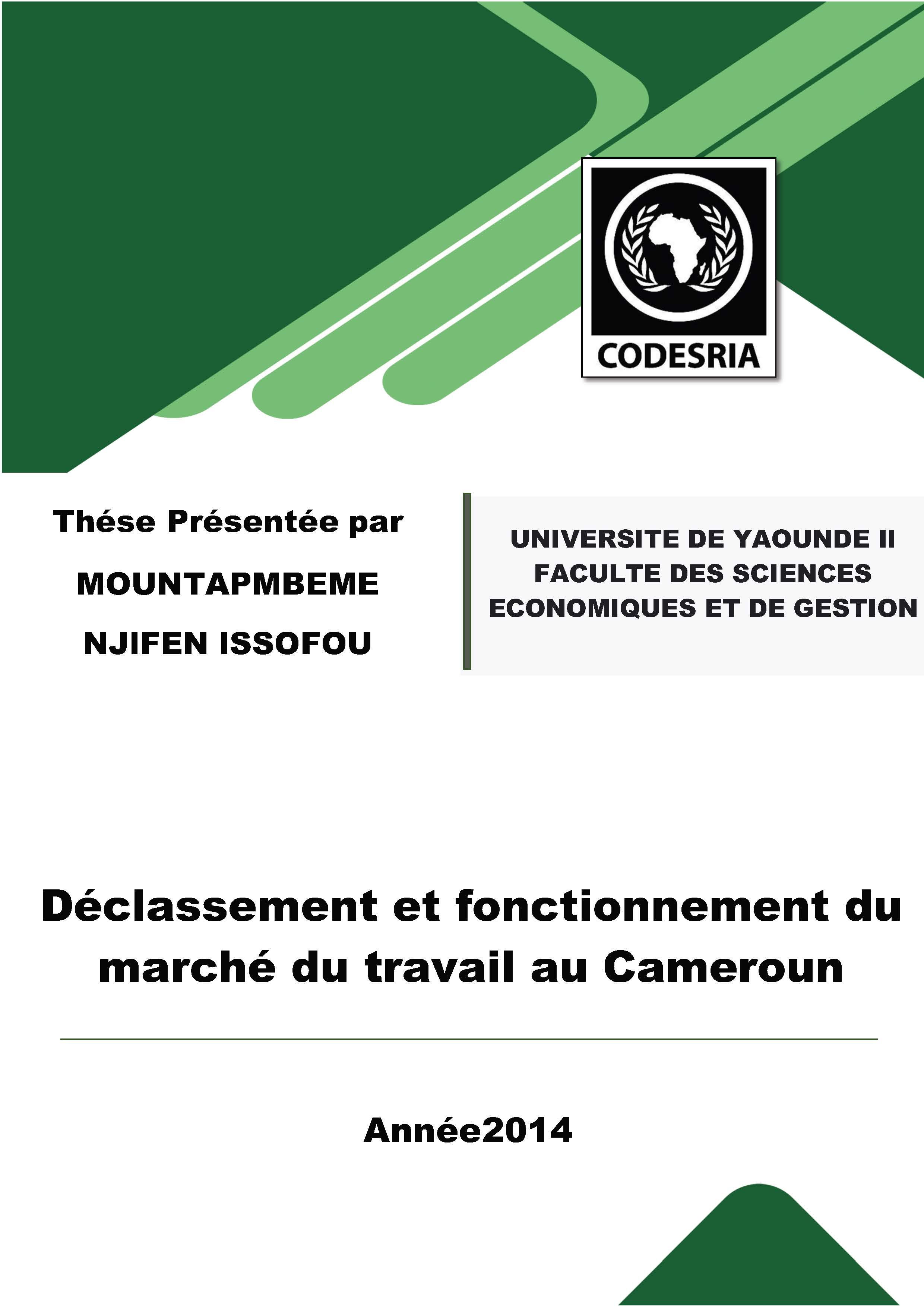Déclassement et fonctionnement du marché du travail au Cameroun
Keywords:
Déclassement, fonctionnement, marché du travail, CamerounSynopsis
Downgrading defined as a situation whose individuals have higher levels of educational attainment than is strictly re~uired for their jobs appears as a form of under-utilization of human skills. Obviously, the development of a country does not depend only on the level of available resources but also how to use them, downgrading constitutes a serious obstacle to socioeconomic development of countries. Y et the downgrading phenomenon is significant in Cameroon; a situation that seems very problematic for valorization and utilization of human resources in the economy; its sources are poorly known fault empirical studies, where the relevance of a thesis on this topic. The objective of this thesis is to show that downgrading is an offshoot of key actor behavior such as employers and workers. To fulfi]] this goal, we use a methodological approach in two stages. The first step focuses on the overeducation in investigating the recent economic literature about different workers and enterprises behaviors. It identifies methodological tools which permit to tag the path of empirical evaluation. Then, quantitative analysis is arranging and use of primary micro data for the purpose of testing previous assumptions. To do this, several statistical and econometric tools tailored to each assumption. At the end of this analysis, it is clear from highlighting the following conclusions. Downgrading in the first job transition is important in Cameroon and this phenomenon is partly explained by the variables related to dysfunctioning labor market including acceptance of employment for reasons of avoiding unemployment and duration of unemployment. The fear of unemployment is a positive factor for downward occupational mobility. The tightening of selection criteria including with exigency of professi6nal experience explains positively downgrading for newcomer workers. Finally, wage rigidity is a positive factor of downgrading in companies. These key findings are used to make policy recommendations to improve the use of existing skills
Downloads
References
Abraham, J. (2003), « Marché interne du travail. Enjeux et limites de la mobilité», Gestion 2000, n° 105, pp. 75 - 96.
Abraham, K. G. et Medoff, J. L. (1985), « Length of service and promotions in union and nonunion work groups », Jndustrial and Labor Relations Review, Volume 38, n° 3, pp. 408- 420.
Acemoglu, D. (1998), «Changes in unemployment and wage inequality: an alternative theory and some evidence», American Economie Review, Volume 89, n°5, pp. 1259-1278.
Acemoglu, D. et Pischke, J. S. (1998), « The structure of wages and Investment in General training», NBER Working Paper, n° 6357.
Affichard, J. (1981), « Quels emplois après l'école ? La valeur des titres scolaires depuis 1973», Economie et Statistique, n° 134.
Aguirregabiria, V et Alonso-Borrego, C. (1997), « Employment Occupational Structure, Technological Capital and Reorganization of Production », UWO Department of Economies Working Papen; 9703, University of Western Ontario, Department of Economics.
Aigner, D. J. et Cain, G. G. (1997), « Statistical Theories of Discrimination in Labor Markets », Jndustrial and Labor Relations Review, Volume 30, n° 2, pp. 175-187.
Alba-Ramirez, A. et blazquez, M. (2002), « Types of Job Match, Overeducation and Labour Mobility in Spain», in Büchel, F., A. De Grip et A. Meitens (eds), Overeducation in Europe: current issues in Theory and policy, Edward Elgar publishing: cheltenham, UK.
Allen, J. et Van Der V el den, R. (2001 ), « Educational Mismatches versus Skill Mismatches: Effects on Wages, Job Satisfaction, and On-the-Job Search, Oxford Economie Papers 3, pp. 434-452.
Ambapour, S. (2009), « Théorie des ensembles flous : application à la mesure de la pauvreté au Congo», BAMSI Document de Travail, n° 16, p.38.
Amossé, T. (2003), « Vingt-cinq ans de transformation des mobilités sur le marché du travail », dans Données Sociales lnsee, pp. 235-242.
Amossé, T. et Gollac, M. (2007), « Intensité du travail et trajectoire professionnelle : le travail intense est-il soutenable?», Document de travail CEE, n° 93, 15p.
Amossé, T., Perraudin, C. et Petit, B. (2012), « Mobilité et segmentation du marché du travail : quels parcours professionnel après avoir perdu ou quitté son emploi ?», Économie et Statistique, n°450, pp. 79-105.






